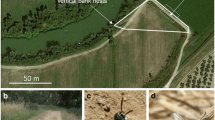Abstract
Females of Elasmucha grisea defend their eggs and small nymphs against invertebrate predators. Females sometimes guard their clutches side by side on the same birch leaf. We studied benefits of this joint guarding both in the field and in the laboratory. We found that adjacent females had significantly larger clutches than solitary females. In the laboratory, we studied the effectiveness of joint versus single defence against ant (Formica uralensis) predators. We established female pairs from initially singly guarding females by cutting off pieces of leaves with egg clutches and pasting them beside another female guarding her clutch. In the control group the females with their clutches were similarly cut off but these clutches were placed on another leaf without any female. The birch twigs where females guarded their clutches were placed in cages in close proximity to laboratory ant nests. In the experimental treatment, two females guarded their clutches together and at the same nest there was another birch twig without a female. In the control treatment two twigs with one female on each were placed close to another ant nest. Two females defended their clutches significantly more successfully, losing fewer eggs than did the single females. This primitive form of female sociality in parent bugs resembles colonial nesting in birds, where communal defence is also important. However, to our knowledge this is the first experiment where the benefit of joint guarding has been tested directly by manipulating the size of the breeding group rather than by measuring the risk of predation in groups of different size.
Similar content being viewed by others
References
Andersson M (1976) Predation and kleptoparasitism by skuas in a Shetland seabird colony. Ibis 118:208–217
Andersson M, Wiklund CG (1978) Clumping versus spacing out: experiments on nest predation in fieldfares Turdus pilaris. Anim Behav 26:1207–1212
Bertram BCR (1980) Vigilance and group size in ostriches. Anim Behav 28:278–286
Birkhead TR (1977) The effect of habitat and density on breeding success in common guillemots, Uria aalge. J Anim Ecol 46: 751–764
Brockmann HJ (1984) The evolution of social behaviour in insects. In: Krebs JR, Davies NB (eds) Behavioural ecology - an evolutionary approach, 2nd edn. Blackwell, London
Brockmann HJ, Dawkins R (1979) Joint nesting in a digger wasp as an evolutionary stable preadaptation to social life. Behaviour 71:203–245
Calvert WH, Hedrick LE, Brower LP (1979) Mortality of the monarch butterfly, Danaus plexippus: avian predation at five over-wintering sites in Mexico. Science 204:847–851
Croze H (1970) Searching image in carrion crows. Z Tierpsychol 5:1–85
Eickwort GC (1981) Presocial insects. In: Hermann HR (ed) Social insects, vol 11. Academic Press, New York
Elgar M (1989) Kleptoparasitism: a cost of aggregating for an orbweaving spider. Anim Behav 37:1052–1055
Fitzgibbon CD (1989) A cost to individuals with reduced vigilance in groups of Thompson's gazelles hunted by cheetahs. Anim Behav 37:508–510
Foster WA, Treherne JE (1981) Evidence for the dilution effect in the selfish herd from fish predation on a marine insects. Nature 295:466–467
Göransson G, Karlsson J, Nilsson SG, Ulfstrand S (1975) Predation on bird's nests in relation to antipredator aggression and nest density: an experimental study. Oikos 26:117–120
Haas V (1985) Colonial and single breeding in fieldfares. Turdus pilaris L.: a comparison of nesting success in early and late broods. Behav Ecol Sociobiol 16:119–124
Horn H (1968) The adaptive significance of colonial nesting in the Brewer's blackbird Euphagus cyanocephalus. Ecology 49:682–694
Jordan K H C (1958) Die Biologic von Elasmuchu grisea L. Beitr Entomol 8:385–397
Kenward RE (1978) Hawks and doves: factors affecting success and selection in goshawk attacks on wood-pigeons. J Anim Ecol 47:449–460
Kruuk H (1964) Predators and anti-predators behaviour of the black headed gull, Larus ridibundus. Behaviour Suppl 11 1–129
Lin CA, Michener CD (1972) Evolution of sociality in insects. Q Rev Biol 47:131–159
Mappes J, Kaitala A (1994) Does a female parent bug lay as many eggs as she can defend? Experiments with Elasmucha grisea L. (Heteroptera; Acanthosomatidae). Behav Ecol 3:314–317
Mappes J, Kaitala A (1995) Host-plant selection and predation risk for offspring of the parent bug. Ecology, in press
Maschwitz U, Gutmann C (1979) Trail and alarm pheromones in Elasmucha grisea (Heteroptera: Acanthosomatidae) (in German). Insectes Soc 26:101–111
Melber A, Schmidt GH (1975a) Sozialverhalten zweier Elasmucha-Arten (Heteroptera: Insecta). Z Tierpsychol 39:403–414
Melber A, Schmidt GH (1975b) Ökologische Bedeutung des Sozialverhaltens zweier Elasmucha-Arten (Heteroptera: Insecta). Oecologia 18:121–128
Melber A, Hölscher L, Schmidt GH (1980) Further studies on the social behaviour and its ecological significance in Elasmucha grisea L. (Hem. -Het.: canthosomatidae). Zool Anz Jena 205:27–38
Michener CD (1958) The evolution of social behavior in bees. In: Proc. 10th Int. Congr. Entomol. 1956. 2, Montreal, pp 442–447
Pamilo P (1982) Multiple mating in Formica ants. Hereditas 97:37–45
Sherman PW (1981) Reproductive competition and infanticide in Belding's ground squirrels and other animals. In: Alexander RD, Tinkle DW (eds) Natural selection and social behaviour: recent research and new theory. Chiron, New York
Sillén-Tulberg B, Leimar O (1988) The evolution of gregariousness in distasteful insects as a defence against predators. Am Nat 132:721–734
Staddon BW (1990) Male sternal pheromone glands in Acanthosomatid shield bugs from Britain. J Chem Ecol 16:2195–2201
Tallamy DW (1985) Egg dumping in lace bugs (Gargaphia solani, Hemiptera: Tingidae). Behav Ecol Sociobiol 17:357–362
Tallamy DW (1986) Age specificity of “egg dumping” in Gargaphia solani (Hemiptera: Tingidae). Anim Behav 34:599–603
Tinbergen N, Impekoven M, Franc D (1967) An experiment on spacing out as a defence against predators. Behaviour 28:307–321
Author information
Authors and Affiliations
Additional information
Communicated by M.A. Elgar
Rights and permissions
About this article
Cite this article
Mappes, J., Kaitala, A. & Alatalo, R.V. Joint brood guarding in parent bugs — an experiment on defence against predation. Behav Ecol Sociobiol 36, 343–347 (1995). https://doi.org/10.1007/BF00167795
Received:
Accepted:
Issue Date:
DOI: https://doi.org/10.1007/BF00167795




